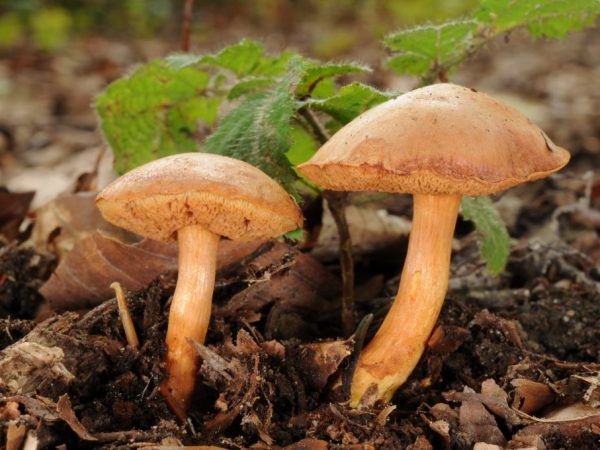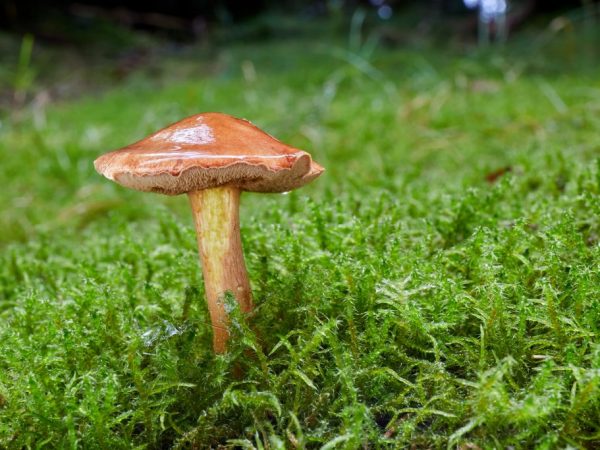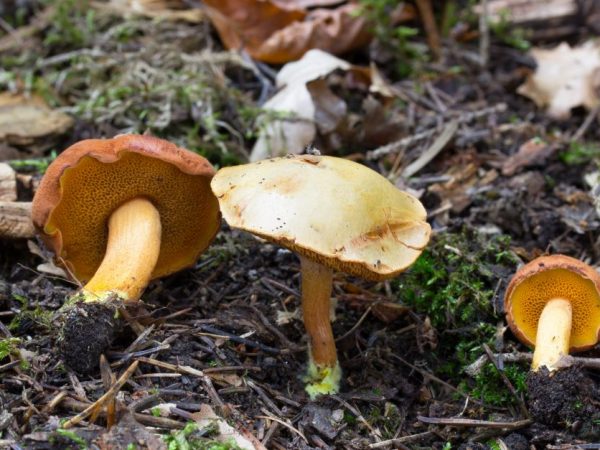Description of pepper mushroom
One of the representatives of the class Agaricomycetes and the Boletov family is a pepper mushroom. It grows throughout the European area and the Far East.

Description of pepper mushroom
Description of the mushroom
Pepper mushroom, or pepper oil can, prefers dry soils and coniferous forests. Mycorrhiza forms with pines and spruces. Less commonly found under cedars. It has an attractive appearance for a novice mushroom picker. Its description:
- a hat of medium diameter (2-6 cm);
- the shape of the hat is convex, rounded;
- rusty to red color;
- the hymenophore is tubular, in color it may coincide with the color of the cap or be darker than it;
- the pulp is homogeneous, yellowish;
- leg height 4-8 cm;
- thickness 1.5-2 cm.
The surface is pleasant to the touch, velvety and dry. At the break, the pulp becomes red. It tastes like pepper, hence its name - "pepper mushroom". The aroma is pleasant.
Spores and spore powder are yellow. There is no ring or “ruffle” on the solid leg; "Skirt" from the remains of a private bedspread.
Fruiting begins on hot July days and lasts until the end of autumn. Grows in small groups of 2-3 pieces.

Pepper mushroom prefers dry soils and coniferous forests
Similar species
Pepper mushroom is sometimes confused with common oil. The main difference is in the taste and red color of the spore-bearing layer. Also, bitter and goat are related to similar species.
Gorchak
Fans of "quiet hunting" know how the pepper mushroom differs from its close relative, the bitter mushroom, or gall mushroom. Its appearance is characterized by the following features:
- the hat is light, beige or brown, with a red tint;
- the leg is uniform, yellowish-orange;
- tubes are light green or brown;
- the taste of the pulp is unpleasant, bitter;
- fine fiber pulp;
- the color of the pulp is white.
Its flesh turns red when cut. The stem is 10 cm high and up to 2.5 cm in diameter. Gorchak is inedible because of its bitter taste. The flesh tastes the same hot-spicy as that of a pepper mushroom. Some mushroom pickers recommend soaking the bittersweet in salt water and then cooking it.
Goat
Another double, a similar edible species, is the goat, or dry oiler. Its description:
- the hat is beige or brown, with a red tint;
- the surface of the cap is slightly mucous;
- the leg is yellow, heterogeneous in color;
- the layer of tubules is milky pink;
- the flesh is pink, tasteless or slightly sour;
- the smell is expressionless.
Goats grow under pines and firs. They feel good on acidic soils, prefer moist places. More often found in Europe and Siberia, in the Far East and the Caucasus. Fruiting of mycelium begins in the last days of summer. Goat is a mycorrhizal forming agent, most often it is typical for pine.
Irina Selyutina (Biologist):
Very often, for some unknown reason, perhaps due to the presence of the word "pepper" in the species name, novice mushroom pickers often confuse pepper mushroom (pepper oil can) and pepper milk mushroom. Not only do they differ sharply in appearance, they also belong to different taxonomic groups:
- pepper mushroom: representative of the Boletov family, genus Halciporus;
- peppercorn: representative of the family Syroezhkovye, genus Mlechnik.
But there is confusion. To prevent this from happening, remember the following features of the appearance of a load of pepper:
- hat: white or with a cream shade, with a diameter of 5 to 20 cm, in the center there may be reddish spots and cracks;
- cap shape: in young mushrooms - slightly convex, in older ones - funnel-shaped;
- the surface of the cap is matte;
- hymenophore: lamellar, represented by narrow plates descending to the pedicle;
- pulp: white, dense and brittle at the same time;
- leg: white, dense, often tapering towards its base, reaches 8 cm in length, thick (up to 4 cm);
- milky juice: white, acrid, turns greenish-olive or bluish on contact with air.
When picking mushrooms, be very careful. Adhere to the golden rule of mushroom pickers: "If you don't know a mushroom, don't pick it up, walk by." Do not taste the mushrooms to determine their edibility - this is fraught with a host of problems, because if there are toxins in the fruiting body of the fungus, they can begin their destructive activity and lead after a while to a number of health problems (at best) or fatal the outcome.
Beneficial features
The composition includes many amino acids useful for humans (for example, valine, asparagine, threonine), including leucine and alanine. Leucine helps to lower the level of the female sex hormone estrone, if it exceeds the norm. Alanine in the liver is converted into glucose and maintains the level of glucose (sugar) in the blood at the level necessary for the human body for normal functioning.
Pepper mushroom is high in natural protein and fiber, phosphorus, magnesium and selenium. Rich in vitamins C, D1, K1, nicotinic, folic and pantothenic acids.
Low calorie content: 22 kcal per 100 g.

Pepper Mushroom Has Many Health Benefits
Application methods
Pepper has found its application in folk and traditional medicine, in cooking and cosmetology.
In traditional medicine
In medicine, the healing properties and chemical composition of this organism are used. Medicines are made from it that have the following effect:
- stabilize pressure;
- stimulate the immune system;
- cleanse the liver;
- destroy cholesterol plaques on the walls of blood vessels;
- strengthen the nervous system;
- activate brain activity;
- increase endurance.
The high content of vitamins helps to restore metabolism, which is useful in the fight against excess weight. Pepper mushroom acts as a natural antibiotic, thanks to the huge amount of phytoncides. This property is used in medicine to fight viral and bacterial infections.
In folk medicine
Narodniks use the mushroom in the preparation of infusions and decoctions. The extract is used to make ointments for warts and papillomas.
Tincture is used to treat purulent conjunctivitis. A moistened gauze or cotton swab applied to the burn helps the quickest scar tissue.
For the treatment of kidney disease, urolithiasis, fried peppercorns are used, carefully soaked and boiled beforehand.
In cooking
Russian biochemists classify pepper pot as an inedible mushroom. They are believed to contain toxins that can cause cancer or cirrhosis of the liver.
In Europe, on the contrary, they claim that these organisms are edible and admire their taste.
In practice, Russian "hunters" have proved that the mushroom is edible, it is not dangerous for humans. It loses its unpleasant stinging taste after boiling and steeping. From such processing, it acquires piquancy and leaves a pleasant aftertaste.
In cooking, this special pepper mushroom is used for pickling, pickling and seasoning, without the addition of pepper.
To make a hot seasoning, the mushrooms are washed and broken into several pieces.After that, boil for 30-40 minutes, drain the water and strain. Spread on a baking sheet and dry in a warm oven for 3-4 hours (readiness is determined visually - they must be completely dry). After that, it is allowed to cool and crushed into powder, additionally dried in a hot oven for several minutes with stirring. And poured into a storage container. This spice is used for sauces, salads, spicy hot dishes, etc.
Conclusion
Picking mushrooms in the forest is fun and enjoyable. You always need to make sure that poisonous specimens do not end up in the basket, carefully sort through the entire harvested crop, wash it and cook it according to a proven recipe.



